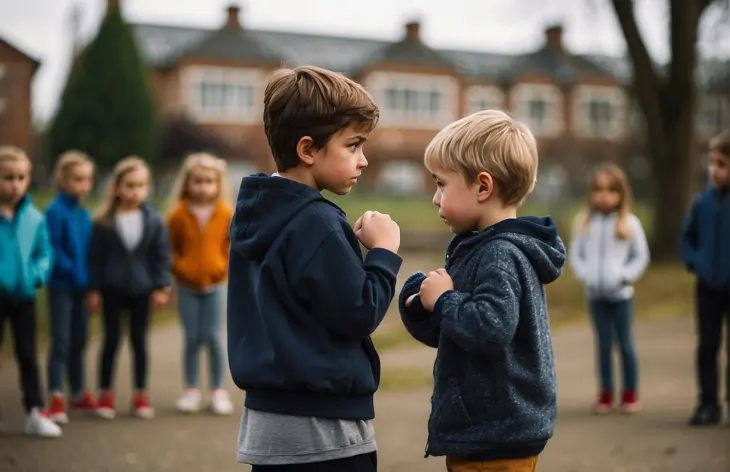Learning that your son got into a fight at school today can be a distressing experience.
It’s important to approach the situation calmly to understand the context of the incident and to provide the appropriate support for your child.
Fights at school can occur for a multitude of reasons, from playful scuffles that go too far to serious confrontations rooted in deeper issues.
It’s essential to get a clear picture of what happened by communicating with your son and school officials to assess the seriousness of the conflict and the reasons behind it.
At this juncture, your role as a parent involves both support and guidance. It’s a delicate balance between acknowledging your child’s feelings and teaching them the appropriate ways to handle conflicts.
Schools today often have systems in place for dealing with fights and it’s beneficial to understand these policies. Nonetheless, your parenting and the home environment has a profound influence on how children manage disagreements and behave in social settings.
By fostering open communication, teaching problem-solving skills, and modeling positive behavior, you can help your son learn to navigate conflicts in a constructive manner.
Key Takeaways
- Understanding the context of the fight is crucial.
- Parental guidance is key in teaching children conflict resolution.
- Communicate with school officials to understand and address the incident.
Understanding Why Children Are Fighting In School
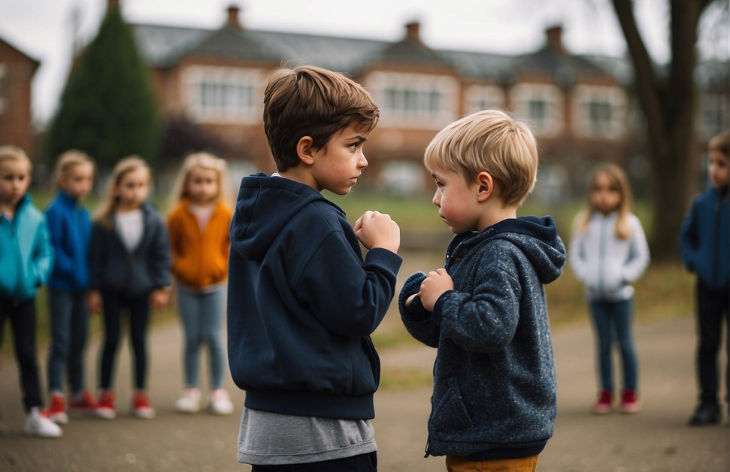
When your child is involved in a school fight, it’s important to consider both the psychological factors at play and the patterns that contribute to such aggressive behavior.
Psychology Behind Aggression
Aggression in children can manifest from internal feelings of anger or frustration. It’s part of their behavioral development as they learn how to cope with emotions and social interactions.
At times, children might struggle with mental health issues, which can further complicate their ability to manage aggressive impulses.
Patterns and Causes of Fighting
Repeated behavior like fighting often has underlying causes. High levels of consistent aggressive behavior could be a sign of a more stable pattern that requires intervention.
Factors contributing to these patterns may include peer influence or a lack of problem-solving skills. In some cases, children who frequently engage in quarrels might have been exposed to violence or have experienced a lack of stability in their environment.
Parental Guidance and Intervention
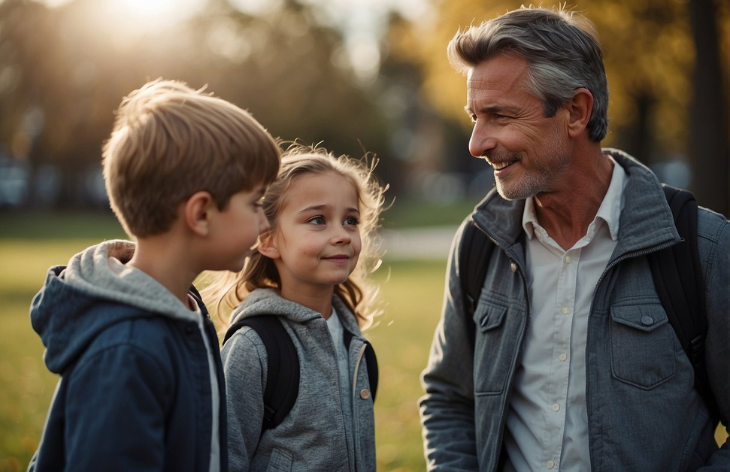
When your son gets into a fight at school, it’s crucial to navigate the situation with a clear strategy. You need to know when to step in and how to apply effective discipline strategies that balance consequences with empowerment and maintain trust.
When to Step In
You must assess the situation to determine if and when your intervention is necessary. At times, allowing natural consequences to unfold teaches invaluable lessons.
However, if the situation poses a risk to safety or could have long-term repercussions, it’s critical to act promptly.
Start by communicating with the school to understand the context of the squabble and gather all the pertinent details before deciding on the appropriate steps you can take.
Effective Discipline Strategies
Your approach to correcting behavior should empower your child to learn from the incident without feeling unduly punished.
Consider implementing logical consequences that are directly related to the fight. For instance, if your child damaged property during the altercation, they should participate in making amends, such as repairing or paying for the damage.
- Communicate the consequences clearly and ensure they are age-appropriate and fair.
- Encourage reflection by discussing the implications of their actions and alternative behaviors for future conflict resolution.
- Use positive reinforcement to commend non-aggressive responses and trust-building behaviors.
Communication and Problem-Solving
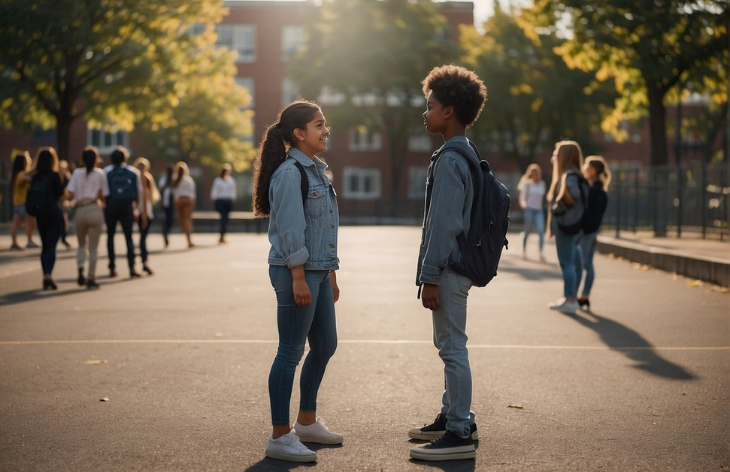
Effective resolution of conflicts like school fights often hinges on robust communication and problem-solving strategies. Here, you’ll explore how to discuss the incident with your child and foster the necessary skills to handle future issues constructively.
Talking With Your Child
Speaking with your child about their involvement in a school fight is crucial. Begin by establishing a non-confrontational atmosphere where your child feels safe to express their feelings and perspective.
Listen actively and acknowledge their emotions, showing that you understand their point of view. Your goal is to gather information, to find out their side of the story, and why the fight happened.
Remember, your approach to communication is key in teaching your child how to effectively share their thoughts and concerns.
Building Problem-Solving Skills
For your child to navigate social challenges, it’s vital to help them develop problem-solving skills they need to navigate conflicts with another child.
Start by discussing nonviolent coping skills that could be used in triggering situations. Teach them steps of problem-solving, which include:
- Identifying the problem
- Brainstorming multiple solutions
- Evaluating the pros and cons of each solution
- Choosing the best option
- Implementing the solution
- Reflecting on the effectiveness of the solution
Your role is to model these steps and guide your child through simulated scenarios. Reinforce that problem-solving is a skill that requires practice, and praise their efforts to improve.
Conflict Resolution Education
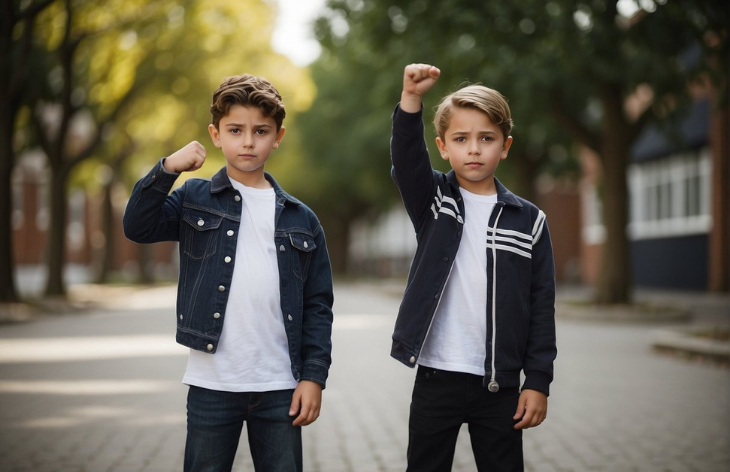
In the context of school environments, conflict resolution education empowers you and your child with strategies to peacefully resolve disagreements. These skills are critical to reducing instances of violence and promoting a safe educational setting.
Teaching Kids to Walk Away
One of the core lessons in conflict resolution is teaching your child when to avoid a heated situation. By recognizing the signs of an escalating argument, your child can learn to walk away before it turns physical.
This isn’t about teaching them to surrender or be passive; it’s about choosing safety and rational action over potential harm.
A practical step might be to have a plan for the next time an altercation seems imminent. Discuss with your child how responding differently next time could lead to a positive outcome. It’s about giving them the tools to identify the point at which disengagement is the best option.
Role-Playing Scenarios
Role-play exercises allow your child to practice conflict resolution in a safe environment. By simulating challenging interactions, your child can better handle real-life conflicts. These scenarios teach negotiation, communication, and empathy, which are key in finding constructive solutions.
Consider setting up role-play sessions where you and your child act out different responses to common disputes. Emphasize the importance of calm dialogue and seeking help from a teacher or another adult if needed. Reinforce the message: conflict resolution skills are power, giving your child the ability to defuse tensions and navigate school life more successfully.
Handling Serious Behavioral Issues
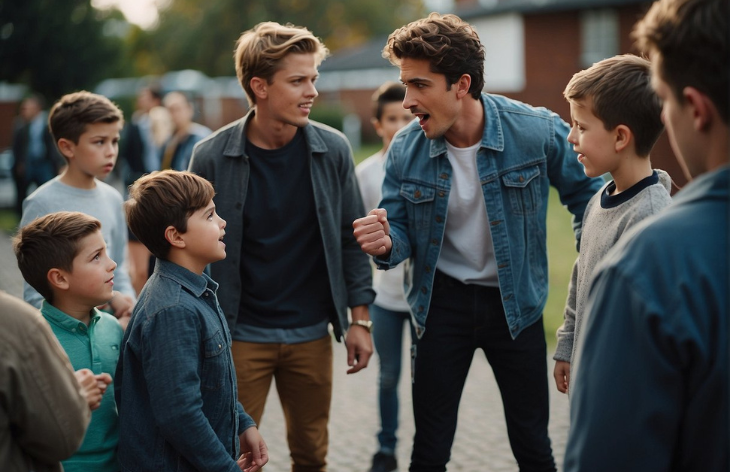
When your child is involved in a squabble at school, it is crucial to address the situation with a structured approach to manage and mitigate any severe behavioral problems.
Identifying Severe Problems
Characteristics of Severe Behavioral Problems:
- Aggressiveness: Signs of violence or physical altercations, like punching or hitting younger kids, indicate that your child may be struggling with aggressive behavior.
- Frequency and Intensity: If these incidents occur regularly and with increasing severity, immediate action is needed.
To identify whether your son’s behavior is a severe problem, monitor for consistent patterns of aggression or defiance. Look for signs that go beyond occasional misbehavior, such as repeated involvement in fights, which signal the need for a detailed evaluation.
Seeking Professional Help
When to Seek Help:
- Immediate Concern: If your kid’s behavior poses a danger to themselves or others, such as engaging in physical fights at school, it’s time you need immediate assistance.
- Mental Health: Mental health experts can assess whether underlying issues are contributing to the behavior, and they can develop intervention strategies tailored to your son’s needs.
Consulting with child psychologists, school counselors, or child behavioral specialists can provide you with strategies and interventions designed to handle serious behavioral issues. These professionals have the expertise to determine if aggressive child behavior forms part of a broader mental health concern that requires specific treatment or therapies.
Frequently Asked Questions
When your child is involved in a school fight, knowing how to navigate the situation is crucial. These FAQs provide guidance on handling the aftermath, understanding the consequences, and preventing future incidents.
How should parents handle the situation when their child is involved in a school fight?
If your child gets into a fight at school, it’s important to remain calm and gather the facts. Contact the school to understand the context and discuss the incident with your child to hear their perspective. Guidance on supporting your son during school struggles can be found in literature like The trouble with boys.
What disciplinary actions are generally taken by schools when a child gets into a fight?
Schools typically have a code of conduct outlining disciplinary actions for fighting, which can include detention, being suspended, or expulsion. The specific consequences depend on the school’s policies and the severity of the fight.
What are the potential legal ramifications of a fight at school?
Legal issues arising from school fights can range from juvenile detention to criminal charges, especially if serious injury occurs or a weapon is involved. It’s imperative to consult with a legal professional if your child faces such accusations.
How can parents effectively communicate with teens to understand why the fight occurred?
Engage in a non-confrontational conversation with your child to understand their feelings and the reasons behind the fight. It is vital to listen empathetically and reassure your child that you want to help them address the underlying issues.
What steps can parents take if their child has been harmed by another student during a school fight?
If your child is injured in a fight, seek medical attention as needed, document the injuries, and report the incident to the school authorities. You may also want to consider speaking with a lawyer if there are concerns about your child’s safety or well-being.
How to address repeat incidents if a child continues to get into fights at school?
Consistent behavior problems may require more than school-imposed discipline.
Seek the assistance of counselors or therapists, investigate potential bullying, and work with the school to create a plan to prevent further incidents.
Understanding the environmental influences on behavior can be informative, as explored in a study on urban African American adolescents.

